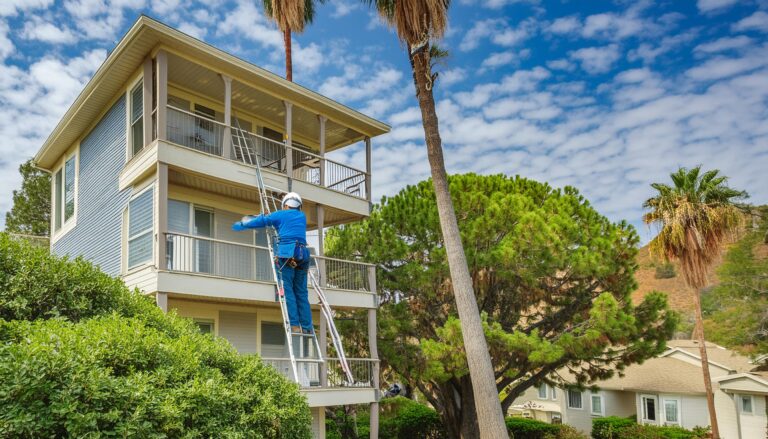What Number of Exterior Elevated Elements Are Required To Be Inspected with SB 326?

Table of Contents
In California, Senate Bill 326 (SB-326) looms large as a critical piece of legislation protecting residents from balcony hazards. While the law is often associated with balconies, the full scope of its inspection requirements extends far beyond these familiar structures. This detailed guide will clarify exactly which elements of your California property fall under SB-326’s purview, ensuring you understand your obligations as a property owner or manager.
What is an Exterior Elevated Element (EEE)?
In simple terms, an EEE is any component of your building that is elevated more than six feet above ground level and designed for human use or occupancy. Think of them as anything you might step out onto or walk across that isn’t at ground level. The key here is that these elements are exposed to the elements, making them susceptible to deterioration and potential safety risks over time.
Contact DrBalcony for a professional inspection!
Ensure the safety of your balcony and living space with DrBalcony - We're a Tech Engineering firm that specializes in California SB326 & SB721 balcony inspections. Over 300+ completed projects in California.
Request A Free EstimateClick To CallThe Essential EEE Inspection Checklist
SB-326 mandates inspections of a representative sample of each type of EEE found within your property. Let’s break down the key elements that fall under this mandate:
- Balconies: While often the focal point of discussion, balcony inspections under SB-326 go beyond surface-level aesthetics. Inspectors will meticulously assess the entire structure, from railings and decking to the underlying supports, connections, and waterproofing systems.
- Decks: Shared decks within common areas are undoubtedly covered by SB-326. However, even smaller, private decks attached to individual units might require inspection if they meet specific criteria outlined in the law.
- Walkways: Elevated walkways connecting different sections of your property are also considered EEEs. These high-traffic areas require careful assessment to ensure their structural soundness, railing integrity, and overall safety.
- Stairs: Any exterior stairs leading to balconies, rooftop areas, or other EEEs fall under the inspection requirements. Inspectors will check for stability, proper handrails, adequate lighting, and any signs of wear or damage.
- Guardrails and Railings: These crucial safety features must meet specific height, design, and strength requirements. Inspectors will meticulously examine their condition, looking for loose connections, corrosion, or any other signs of compromise.
- The Unexpected EEEs: Don’t be surprised if the inspection extends beyond the obvious elements. Attached structures like awnings, pergolas, and even some light fixtures may be considered EEEs if they are elevated and accessible.
The Waterproofing Factor
SB-326 also mandates inspection of the waterproofing systems associated with these elevated elements. This includes flashing, sealants, membranes, and other materials designed to prevent water intrusion and protect the underlying structure from damage.
Why Compliance Matters?
Regular inspections ensure that your property’s EEEs are safe, compliant, and structurally sound. By addressing any issues early on, you can prevent costly repairs, potential accidents, and liability concerns.
Contact DrBalcony for a professional inspection!
Ensure the safety of your balcony and living space with DrBalcony - We're a Tech Engineering firm that specializes in California SB326 & SB721 balcony inspections. Over 300+ completed projects in California.
Request A Free EstimateClick To CallDrBalcony: Your Partner in SB 326 Compliance
Navigating the complexities of SB 326 can be daunting, but our team of experts at DrBalcony is here to help. We offer comprehensive inspections, detailed reports, and practical solutions tailored to your specific needs. Don’t leave your property’s safety to chance – contact us today to schedule your SB-326 inspection and protect your investment.
FAQ Section: Top Questions & Answers
My property is well-maintained. Do I really need SB-326/SB-721 inspections?
YES! Even with excellent maintenance, hidden issues can develop due to construction errors, material flaws, or severe weather exposure. Inspections are about ensuring those don’t turn into major problems.
Our balconies were inspected a few years ago – isn't that enough?
Unfortunately, no. California laws mandate inspections on a set schedule, often every 6 years. Deterioration can happen quickly, making regular assessments essential.
Can I use my regular handyman for the balcony inspection?
It’s not recommended. Unless they hold specific licenses (architect, structural engineer, etc.) their inspection won’t be considered valid for SB-326/SB-721 compliance.
What if the inspection uncovers major issues?
First, don’t panic! Early detection often means less extensive (and expensive) repairs are needed. Work with your inspector to prioritize fixes, and explore if they offer repair services for a streamlined solution.
I'm worried about the cost of inspections. Are there any resources to help?
Start by getting detailed quotes from multiple companies. Factor in that proactive inspections help you avoid even bigger costs down the line due to neglected problems. Some property management associations offer guidance on budgeting for balcony compliance.
